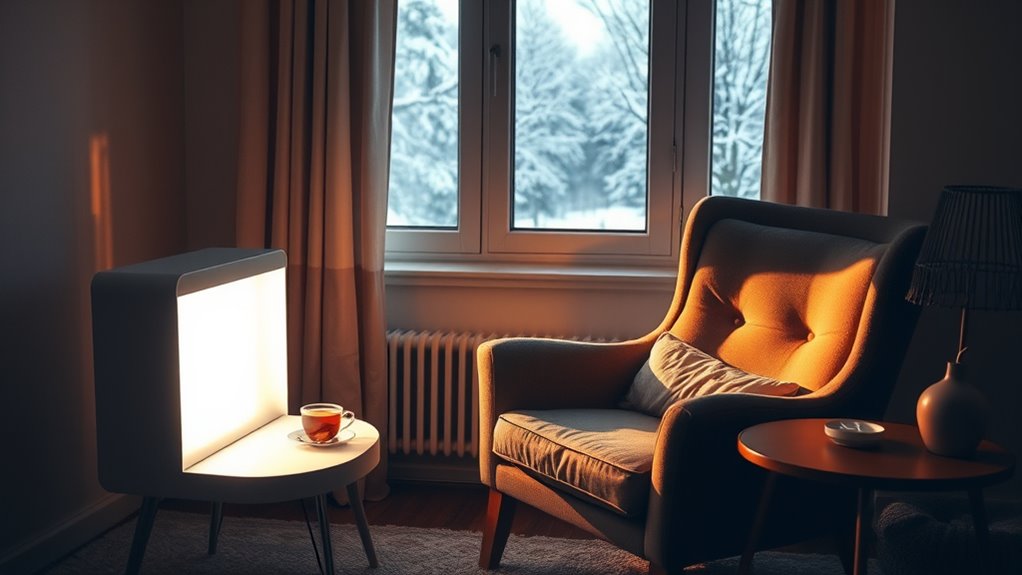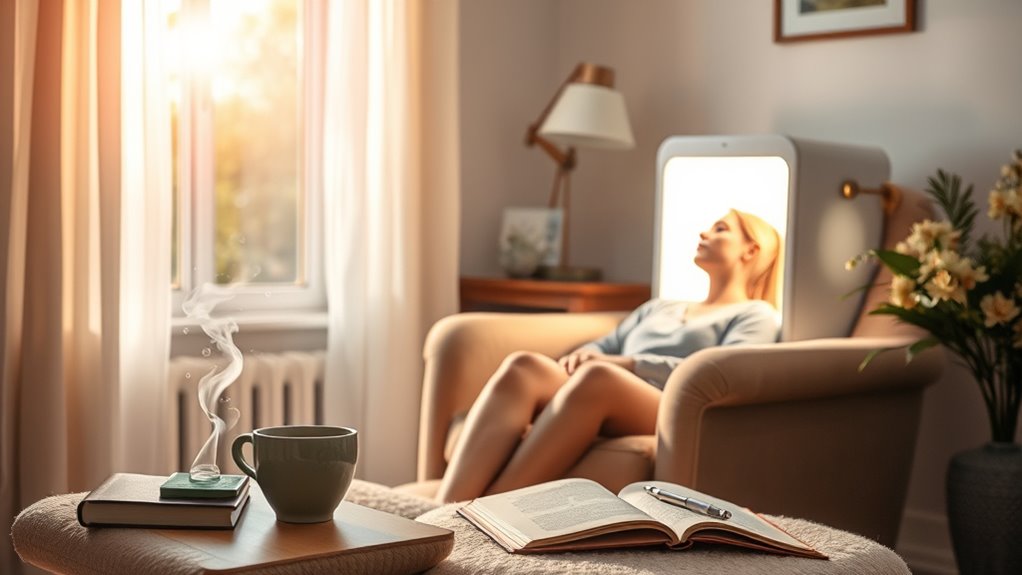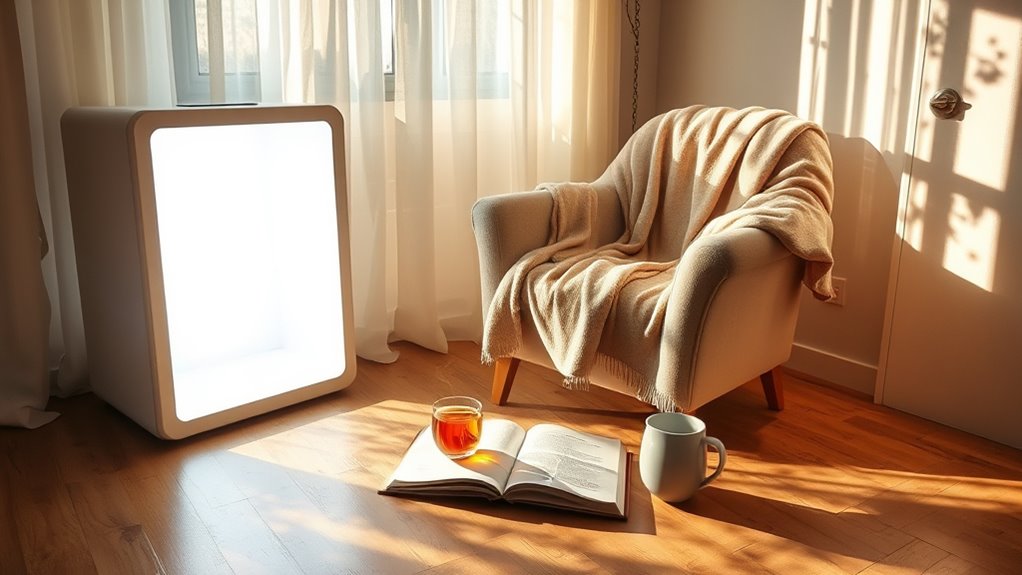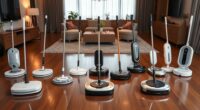Light therapy works by mimicking natural sunlight, helping you stabilize your mood and regulate your circadian rhythms. This can alleviate symptoms of Seasonal Affective Disorder (SAD) and improve sleep quality. By using a light box that emits 10,000 lux, ideally in the morning, you can enhance serotonin and melatonin levels, promoting better sleep patterns. Alongside other treatments, light therapy can greatly boost your overall well-being. There’s much more to discover about its benefits and best practices.
Key Takeaways
- Light therapy mimics natural sunlight, helping to regulate circadian rhythms and alleviate symptoms of Seasonal Affective Disorder (SAD).
- Exposure to 10,000 lux light boxes improves serotonin and melatonin levels, enhancing mood and stabilizing sleep patterns.
- Daily sessions of 20 to 40 minutes are recommended, ideally in the morning, for optimal effectiveness in treating SAD and sleep issues.
- Light therapy can improve sleep quality by reducing insomnia symptoms and promoting longer sleep duration and enhanced overall sleep satisfaction.
- Combining light therapy with antidepressants or cognitive behavioral therapy can further enhance treatment outcomes for SAD and associated sleep disturbances.
Understanding Seasonal Affective Disorder (SAD)

When the days grow shorter and sunlight becomes scarce, many people may find themselves grappling with Seasonal Affective Disorder (SAD). This mood disorder typically surfaces in the fall and winter months, largely due to reduced sunlight exposure.
You might experience symptoms like fatigue, mood changes, disrupted sleep patterns, and difficulty concentrating, which can hinder daily functioning. SAD disrupts your circadian rhythm, leading to imbalances in serotonin and melatonin levels, contributing to depressive feelings. Additionally, certain foods rich in dietary fiber can help support overall mental health during these challenging months. Regular health checks for signs of illness or injury can also promote better mental well-being.
If you have a history of depression, you might be more susceptible to SAD, especially in regions with longer winters. Fortunately, treatment options like light therapy can effectively improve mood and alleviate symptoms by mimicking natural sunlight, helping you regain balance during those darker months. Budgeting for mental health is an important aspect of managing overall well-being.
The Science Behind Light Therapy

Light therapy operates on a simple yet effective principle: by exposing you to bright light that mimics natural sunlight, it can help regulate your body’s internal clock and improve your mood. This method involves using a specialized light box that emits about 10,000 lux, ensuring you receive the benefits without harmful UV rays. For those with Seasonal Affective Disorder (SAD), light therapy can markedly improve SAD symptoms by influencing serotonin and melatonin production, vital for mood stabilization and circadian rhythm sleep. Additionally, green juice can provide essential nutrients that support overall health and energy levels, which may complement the benefits of light therapy. Establishing consistent routines can also enhance emotional security during treatment.
Moreover, engaging in regular cycling activities can boost physical health and positively influence mood, further supporting the advantages of light therapy. Daily sessions lasting 20 to 40 minutes, ideally in the morning, optimize effectiveness. Many individuals notice symptom relief within a week, and combining light therapy with antidepressants can further enhance mood stabilization in cases of major depressive disorder. Additionally, air purifiers with HEPA filtration can complement light therapy by improving indoor air quality, which is crucial for overall well-being.
How Light Therapy Affects Circadian Rhythms

Circadian rhythms, your body’s natural internal clocks, can easily get thrown off by the lack of sunlight during the colder months.
Light therapy, especially bright light therapy, mimics natural sunlight to help realign these rhythms, which is essential for those experiencing Seasonal affective disorder (SAD). By exposing yourself to bright light for 20-30 minutes in the morning, you can trigger changes in hormone production, particularly melatonin and serotonin. Additionally, the importance of selecting the right cold medication should be noted, as it can influence overall well-being during winter months. Incorporating wellness topics into your daily routine can further enhance your health during this time. Engaging in practices that promote high vibrational energy can also help in maintaining a positive mindset throughout the season. According to research, mammography guidelines indicate the importance of early detection in health management, which can also apply to maintaining mental health during seasonal changes.
This exposure helps regulate sleep and mood, making it easier to combat sleep issues. Studies show that consistent light therapy can shift your circadian rhythms, reinforcing your body’s natural cues and enhancing alertness while improving sleep quality. Additionally, light therapy’s ability to enhance accessibility for diverse learning populations illustrates its potential benefits beyond just mood and sleep regulation.
Embrace light therapy to regain balance in your daily life.
Choosing the Right Light Box for Your Needs

Choosing the right light box is crucial for effectively managing Seasonal Affective Disorder (SAD) and enhancing your overall well-being. Here are key factors to take into account:
- Light Intensity: Look for a light box that emits 10,000 lux for ideal effectiveness.
- UV Light Protection: Make sure it filters out most or all UV light to protect your eyes.
- Design for SAD: Choose a light box specifically made for treating seasonal affective disorder, as not all options provide the necessary intensity or spectrum. HEPA filters are especially effective in improving indoor air quality, which can also positively influence mood and sleep. Additionally, incorporating light therapy into your routine can enhance your overall mental health. Using a light box can complement other treatments, such as unique homemade fruit juice recipes, to boost your nutrition and mood.
- Size and Portability: Think about the size and style to fit your daily routine seamlessly.
For personalized advice, consult with a healthcare provider or eye specialist, especially if you have any existing eye conditions. Regularly monitoring air quality indices can also help in understanding how environmental factors may affect your mood and sleep.
Recommended Usage Guidelines for Light Therapy

For ideal results, using light therapy for Seasonal Affective Disorder (SAD) typically requires a daily commitment of 20 to 30 minutes.
It’s best to schedule your sessions within the first hour of waking. Your light box should emit a brightness of 10,000 lux and be positioned 16 to 24 inches away from your face, without direct eye contact. Incorporating hydration strategies alongside light therapy can further support optimal brain function and mood. Utilizing airless paint sprayers in your environment can also contribute to a more visually stimulating atmosphere, which may enhance mood. Additionally, maintaining skin hydration is important for overall health and can support your body’s response to light therapy. Research shows that hydrating ingredients in your skincare can improve skin texture, making it more receptive to light therapy.
Consistent daily use is essential until natural sunlight returns in spring, helping to realign your circadian rhythms. To avoid disrupting your sleep cycles, steer clear of light therapy late in the day.
Keep an eye out for side effects like eye strain or headaches, and don’t hesitate to consult a healthcare provider for personalized guidance and adjustments as needed. Additionally, consider that consistent daily use can significantly enhance your overall well-being and effectiveness of the therapy.
Potential Benefits of Light Therapy for Sleep Issues

Light therapy can greatly improve your sleep quality and help regulate your sleep patterns.
By using bright light exposure, you might find it easier to fall asleep and wake up feeling refreshed.
This approach not only enhances your overall mood but also boosts your energy levels throughout the day. Additionally, regular exposure to bright light can reduce symptoms of anxiety and depression, thereby further supporting better sleep and emotional well-being.
Improved Sleep Quality
Improved sleep quality is one of the most promising benefits of light therapy, especially for those struggling with sleep issues tied to Seasonal Affective Disorder (SAD).
By regulating circadian rhythms, light therapy can greatly enhance your sleep experience. Here’s how it helps:
- Reduces insomnia symptoms: Many users notice improvements within a week.
- Promotes better sleep onset: Light therapy aids in falling asleep more quickly.
- Enhances sleep duration: Regular sessions can lead to longer, uninterrupted sleep.
- Boosts overall sleep satisfaction: Fewer nighttime awakenings contribute to a more restful night.
Regulated Sleep Patterns
When it comes to regulating sleep patterns, light therapy offers a powerful tool for those struggling with sleep issues. By aligning your circadian rhythms with natural sunlight, light therapy can boost the production of melatonin and serotonin, which are essential for sleep quality.
Morning exposure to bright light helps your brain lower melatonin levels, promoting daytime alertness and facilitating better sleep at night. Clinical studies reveal that light therapy effectively reduces insomnia symptoms, leading to improved sleep quality and duration.
Additionally, it can help manage circadian rhythm sleep disorders, ensuring more consistent sleep-wake cycles. When combined with cognitive behavioral therapy (CBT), light therapy enhances mental health outcomes, making it a valuable option for anyone seeking better sleep.
Safety Considerations and Side Effects of Light Therapy

When considering light therapy, it’s important to be aware of possible side effects like headaches and eye strain.
You should consult a healthcare provider, especially if you have bipolar disorder or eye conditions.
Additionally, always follow safety precautions to protect your eyes and guarantee effective use of the therapy.
Common Side Effects
Light therapy can offer significant benefits for those dealing with Seasonal Affective Disorder (SAD) and sleep issues, but it’s important to be aware of potential side effects.
Here are some common side effects you might experience:
- Headaches
- Eye strain and blurry vision
- Fatigue
- Light sensitivity
Consult a healthcare provider before starting light therapy, especially if you have bipolar disorder or existing eye conditions.
Monitoring for adverse reactions during your sessions is essential, as adjustments to dosage or duration may be necessary based on your individual response.
While these side effects are generally mild and transient, being informed helps guarantee your safety and the effectiveness of your treatment.
Eye Safety Precautions
While light therapy can be an effective treatment for SAD and sleep issues, it’s crucial to contemplate eye safety precautions to prevent potential harm.
To protect your eyes, verify that your light box emits minimal to no UV radiation, as prolonged exposure can lead to eye damage. If you have a history of eye conditions like glaucoma or cataracts, consult an eye specialist before starting therapy.
Position the light box 16 to 24 inches away from your face and avoid direct eye contact to reduce discomfort. Be aware of side effects such as headaches and eye strain; these usually resolve with adjusted settings.
Monitor for any adverse reactions and report concerns to your health care provider immediately.
Consultation Recommendations
Before starting light therapy, it’s essential to consult with a healthcare provider, especially if you have bipolar disorder or existing eye conditions. This step helps tailor the treatment to your individual needs and guarantees safety.
Here are some key considerations:
- Discuss any medications that may increase light sensitivity.
- Monitor for mild side effects like headaches, eye strain, and fatigue during treatment.
- Follow up regularly with your healthcare provider to assess effectiveness and make necessary adjustments.
- Adjust the duration and intensity of light exposure based on your responses to the therapy.
Combining Light Therapy With Other Treatments for SAD

Combining light therapy with other treatments can greatly enhance your experience in managing Seasonal Affective Disorder (SAD). When you pair light therapy with antidepressants, especially selective serotonin reuptake inhibitors (SSRIs), you can see symptom improvement more rapidly than with either treatment alone.
Light therapy helps balance serotonin levels, essential for mood regulation during the darker months. Additionally, incorporating cognitive behavioral therapy (CBT) can address underlying thought patterns while light therapy targets physiological symptoms, creating a holistic approach.
Studies show that this combination can boost treatment effectiveness, yielding a 40% to 60% improvement in symptoms. Regular use of light therapy, ideally for 20-30 minutes daily, can also enhance sleep patterns, further alleviating mood and insomnia issues associated with SAD.
Frequently Asked Questions
How Long Does Light Therapy Take to Work for Insomnia?
Light therapy can show improvements in your insomnia symptoms within just a week if you respond well to the treatment.
Most people notice enhanced sleep quality and mood after consistent use.
Typically, sessions last 20 to 40 minutes, and longer sessions can boost results, especially with lower-intensity light boxes.
For the best effect, use a 10,000 lux light box daily in the morning to help realign your circadian rhythms.
Do SAD Therapy Lights Really Work?
Imagine stepping into a sunbeam on a dreary winter’s day; that’s the essence of SAD therapy lights.
Yes, they really work! Many users report feeling brighter and more energized after consistent sessions.
By bathing yourself in this artificial sunlight for about 20-30 minutes each morning, you can boost your mood and regulate your sleep patterns.
It’s like a gentle nudge to your brain, helping it produce the feel-good hormones you need.
How Effective Is Light Therapy for Sleep?
Light therapy can be highly effective for improving your sleep quality.
By using a light box that emits 10,000 lux for 20 to 40 minutes each morning, you can help realign your circadian rhythms.
Many people report noticeable improvements in sleep scores within a week of consistent use.
If you’re struggling with insomnia or sleep disturbances, incorporating light therapy into your routine could lead to better rest and overall well-being.
Can SAD Lamps Help With Insomnia?
Using a SAD lamp can be like turning on a switch for your sleep. It can definitely help with insomnia, especially if you struggle during the darker months.
Conclusion
Incorporating light therapy into your routine can be a game-changer for managing Seasonal Affective Disorder and sleep issues. By harnessing the power of bright light, you can boost your mood and reset your circadian rhythms, making those dark winter months feel like a walk in the park. Just remember to choose the right light box and follow the guidelines for ideal results. With a little patience, you might just find yourself shining brighter than ever before!









